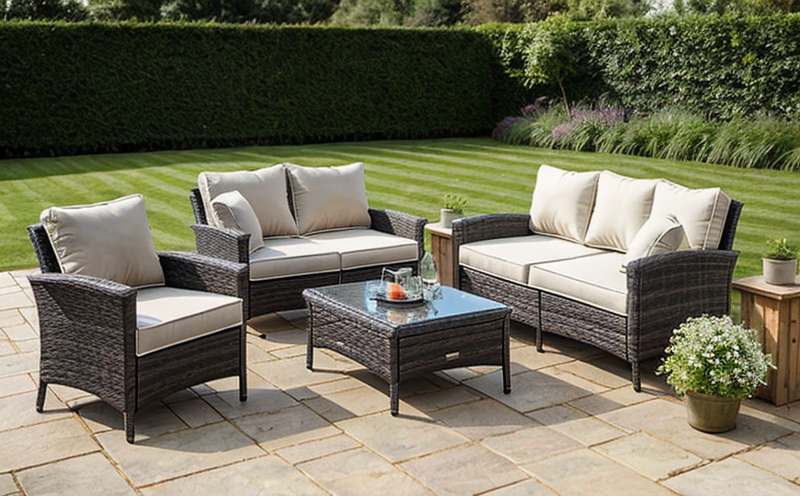BS EN 581-3 Outdoor Tables Mechanical Strength and Durability Testing
The British Standard EN 581-3 specifies the requirements, test methods, sampling procedures, and acceptance criteria for outdoor tables. This standard ensures that furniture is designed to withstand the harsh elements of outdoor environments. The mechanical strength and durability testing outlined in this standard are crucial for quality managers and compliance officers looking to ensure their products meet international standards.
Outdoor tables are subjected to various environmental stresses such as extreme temperatures, humidity, UV radiation, and physical wear from users. These factors can significantly impact the structural integrity of furniture over time. The BS EN 581-3 tests aim to evaluate how well the furniture performs under these conditions.
The testing process involves several steps, starting with specimen preparation. This includes selecting representative samples that reflect the expected usage and environmental exposure. Once prepared, the specimens undergo a series of mechanical strength and durability assessments using standardized equipment. The tests simulate real-world conditions to provide an accurate reflection of the furniture's performance.
One of the key aspects of this testing is the assessment of static load capacity. This involves applying defined loads to the table top and legs to determine how much weight it can safely support without compromising its structural integrity. Another critical test is the determination of dynamic load resistance, which simulates the impact forces that occur when users sit or walk on the furniture.
Environmental factors play a significant role in the durability of outdoor furniture. The tests account for these by subjecting specimens to accelerated aging processes, such as high-temperature exposure and UV radiation simulation, to mimic long-term weathering effects. These environmental stresses help predict how quickly the furniture might degrade under actual use.
The acceptance criteria specified in BS EN 581-3 are stringent and ensure that only products meeting these standards can be considered suitable for outdoor environments. Compliance with these criteria is essential for manufacturers to ensure their products meet regulatory requirements and consumer expectations.
For R&D engineers, this testing provides valuable data on the performance limits of different materials and designs. This information can guide future product development by identifying areas where improvements are needed. Quality managers also benefit from this testing as it helps in maintaining consistent product quality across production batches. Compliance officers ensure that all products meet regulatory standards, thus reducing the risk of non-compliance penalties.
Customer Impact and Satisfaction
- Enhanced Product Durability: By ensuring compliance with BS EN 581-3, manufacturers can provide customers with furniture that is designed to last longer. This reduces the need for frequent replacements, which ultimately enhances customer satisfaction.
- Better User Experience: Furniture that meets these standards will be more robust and less likely to break under typical use conditions, leading to a better overall user experience.
International Acceptance and Recognition
The BS EN 581-3 standard is widely recognized and accepted across Europe and beyond. Its acceptance contributes to the harmonization of technical requirements among different countries, facilitating easier trade and standardization in the furniture industry. Compliance with this standard ensures that products are compatible with international markets, thereby enhancing marketability.
Many leading furniture manufacturers have adopted BS EN 581-3 as a benchmark for their product quality. This recognition has led to increased trust among customers and has contributed to the reputation of these brands in the global market. The standard's widespread acceptance also ensures that products are consistent with international best practices, further enhancing customer confidence.
Adopting this standard not only meets regulatory requirements but also sets a higher bar for product quality. This can lead to increased demand and better positioning in competitive markets. By aligning with international standards, manufacturers demonstrate their commitment to excellence, which is crucial for maintaining a positive brand image and customer loyalty.
Environmental and Sustainability Contributions
- Eco-friendly Design: By ensuring that furniture meets the stringent requirements of BS EN 581-3, manufacturers can design products that are more durable and less prone to premature failure. This reduces waste and the need for frequent replacements, which is beneficial for both the environment and consumers.
- Resource Efficiency: Longer-lasting furniture means better use of resources during production. With reduced turnover rates, there is less demand for new raw materials, contributing positively to resource efficiency.





